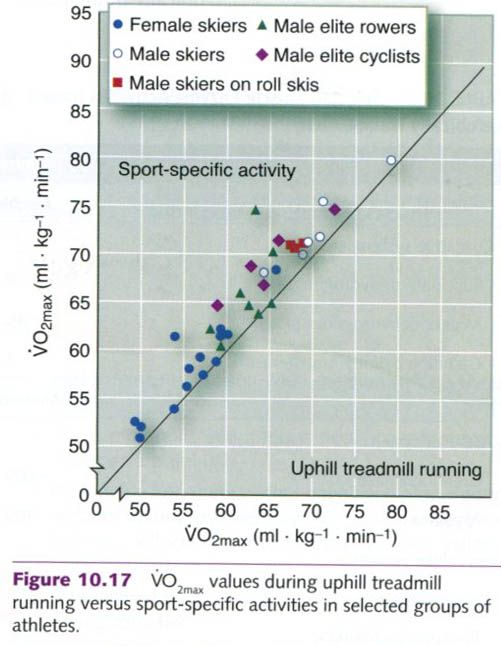This concept is also important in testing of
athletes. As an example, to accurately measure endurance improvements, athletes
should be tested while engaged in an activity similar to the sport or activity
in which they usually participate. Consider one study of highly trained rowers,
cyclists, and cross-country skiers. Their VO2max values were
tested while they performed two types of work: uphill running on a treadmill and maximal performance of their specific
sport activity. The important finding, shown in figure below, was that the
VO2max values attained by all the athletes during their
sport-specific activity were as high as or higher than the values obtained on
the treadmill. For many of these athletes, VO2max values were
substantially higher during their sport-specific activity.
A highly creative design for studying the
concept of specificity of training involves one-legged exercise of specificity
of training involves one-legged exercise training, with the untrained opposite
leg used as the control. In one study, subjects were placed in three groups: a
group that sprint trained one leg and endurance trained the other, a group that
sprint trained one leg and did not train the other, and a group that endurance
trained one leg and did not train the other. Improvement in VO2max
and lowered heart rate and blood lactate response at submaximal work rates were
found only when exercise was performed with the endurance-trained leg.
Much of the training response occurs in the
specific muscles that have been trained, possibly even in individual motor
units in a specific muscle. This observation applies to metabolic as well as
cardiorespiratory responses to training. Table below shows the activities of
selected muscle enzymes from the three energy systems for untrained,
anaerobically trained, and aerobically trained men. The table shows that
aerobically trained muscles have significantly lower glycolitic enzyme
activities. Thus, they might have less capacity for anaerobic metabolism or
might rely less on energy from glycolysis. More research is needed to explain
the implications of the muscular changes accompanying both anaerobic and
aerobic training, but this table clearly illustrates the high degree of
specificity to a given training stimulus.
|
Selected
muscle enzyme activities(mmol x g-1 x min-1) for
anaerobically trained, and aerobically trained men
|
|||||||
|
|
Untrained
|
Anaerobically
trained
|
Aerobically
trained
|
||||
|
Aerobic
enzymes
|
|||||||
|
Succinate dehydrogenase
|
8.1
|
8.0
|
20.8
|
||||
|
Malate dehydrogenase
|
45.5
|
46.0
|
65.5
|
||||
|
Carnitine palmytil transferase
|
1.5
|
1.5
|
2.3
|
||||
|
Anaerobic
enzymes
|
|||||||
|
Creatine kinase
|
609.0
|
702.0
|
589.0
|
||||
|
Myokinase
|
309.0
|
350.0
|
297.0
|
||||
|
Phosphorylase
|
5.3
|
5.8
|
3.7
|
||||
|
Phosphofructokinase
|
19.9
|
29.2
|
18.9
|
||||
|
Lactate dehydrogenase
|
766.0
|
811.0
|
621.0
|
||||
Cross-training refers to training for more than one sport at
the same time or training for several different fitness components(such as
endurance, strength, and flexibility) at one time. The athlete who trains by
swimming, running, and cycling in preparation for competing in a triathlon is
an example of the former, and the athlete involved in heavy resistance training
and high-intensity cardiorespiratory training at the same time is an example of
the latter.
For the athlete training for cardiorespiratory
endurance and strength at the same time, the studies conducted to date indicate
that gains in strength, power, and endurance can result. However, the gains in
muscular strength and power are less when strength training is combined with
endurance training than when strength training alone is done. The opposite does
not appear to be true: improvement of aerobic power with endurance training
does not appear to be attenuated by inclusion of a resistance training program.
In fact, short-term endurance can be increased with resistance training.
Although earlier studies supported the conclusion that concurrent strength and
power, one well-controlled study did not show this. McCarthy and colleagues
reported similar gains in strength, muscle hypertrophy, and neural activation in a group of previously untrained
subjects who underwent concurrent high-intensity strength training and cycle
endurance training compared with a group who performed only high-intensity
strength training.










0 коментара:
Постави коментар